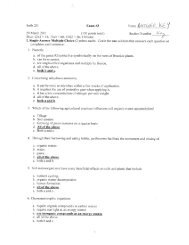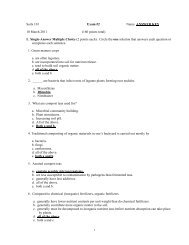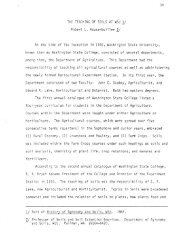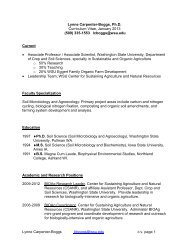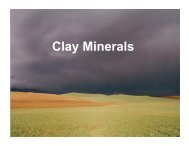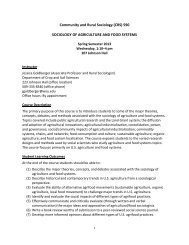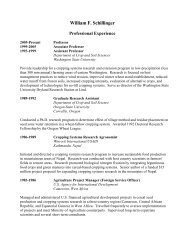2012 Dryland Field Day Abstracts - Dept. of Crop and Soil Sciences ...
2012 Dryland Field Day Abstracts - Dept. of Crop and Soil Sciences ...
2012 Dryland Field Day Abstracts - Dept. of Crop and Soil Sciences ...
Create successful ePaper yourself
Turn your PDF publications into a flip-book with our unique Google optimized e-Paper software.
Part 4. bioenergy cropping systems research Page 59<br />
2010, <strong>and</strong> the forage was ensiled. Lactating dairy cows were fed either a control total mixed ration (TMR), or a TMR with 9%<br />
canola/pea silage that replaced a portion <strong>of</strong> the alfalfa hay <strong>and</strong> corn silage. After 21 days the canola/pea silage was increased to<br />
15% <strong>of</strong> the TMR.<br />
Both peas <strong>and</strong> winter canola had good st<strong>and</strong>s. Swathing yielded approximately 2000 lbs forage dry matter/acre at 31% DM.<br />
Ensiling the forage crop <strong>and</strong> feeding it as part <strong>of</strong> a TMR avoided potential problems that might occur with direct grazing. Most<br />
notably, nitrate-N concentration was reduced 80% by ensilage. The canola/pea silage was palatable to the cows <strong>and</strong> substituted<br />
well for alfalfa or corn silage into a TMR without affecting milk production<br />
or composition. Plant regrowth following swathing was sufficient for<br />
winter survival, <strong>and</strong> canola harvested in 2011 yielded 2200 lbs/acre. The<br />
grain was commercially processed for oil (biodiesel) <strong>and</strong> meal (animal<br />
feed), thereby completing the trifecta from a single crop planting.<br />
Biennial forage canola appears to be a viable option in crop rotation<br />
systems in dryl<strong>and</strong> areas to diversify crop production <strong>and</strong> obtain forage<br />
for ruminants.<br />
Oilseed Analysis at WSU<br />
Ian Burke <strong>and</strong> Pat Fuerst, <strong>Dept</strong>. <strong>of</strong> <strong>Crop</strong> <strong>and</strong> <strong>Soil</strong> <strong>Sciences</strong>, WSU<br />
The Weed Science laboratory provides oilseed quality analysis as a service in support <strong>of</strong> the field research component <strong>of</strong> the WA<br />
Bi<strong>of</strong>uels <strong>Crop</strong>ping Systems Research <strong>and</strong> Extension project. Data produced includes parameters such as oil yield from a seed<br />
crusher, total oil content, <strong>and</strong> fatty acid composition. Fatty acid composition is the key determinant <strong>of</strong> oil quality for biodiesel, <strong>and</strong><br />
enables an evaluation <strong>of</strong> potential for biodiesel from canola, camelina, <strong>and</strong> other oilseed crops from seed samples produced in<br />
field plots. The objective <strong>of</strong> the research is to support research <strong>and</strong> extension personnel in developing input recommendations<br />
based not just on yield but on quantity <strong>and</strong> quality <strong>of</strong> oil.<br />
Almost 2000 oilseed samples have been submitted for analysis<br />
by WSU researchers since 2008. The most recent set <strong>of</strong><br />
samples (825 total) we are processing are from camelina trials<br />
at several locations in the PNW. Correlating crop yield <strong>and</strong> oil<br />
analysis by agroclimatic zones, varieties, fertilizer rates, <strong>and</strong><br />
other factors will allow more site-specific crop<br />
recommendations to growers <strong>and</strong> processors for maximum<br />
potential seed <strong>and</strong> oil production.<br />
Winter Canola Seeding Rate <strong>and</strong> Date Study in North Central Washington<br />
Frank Young 1 , Dennis Roe 2 , Larry McGrew 1 , Dale Whaley 2 , <strong>and</strong> Chasity Watt 3 ;<br />
1 USDA-ARS Pullman; 2 WSU; 3 Colville Confederated Tribes (CCT)<br />
Canola oil <strong>and</strong> meal after seed crushing. After being weighed,<br />
the samples are analyzed for oil composition <strong>and</strong> quality.<br />
Approximately 60% <strong>of</strong> the cereal production area <strong>of</strong> the PNW are characterized by the winter wheat/summer fallow system. This<br />
system is plagued by winter annual grass weeds such as jointed goatgrass, feral rye, <strong>and</strong> downy brome. Growers are becoming<br />
more interested in producing winter canola in this region to improve pest management strategies, diversify markets (food, fuel,<br />
<strong>and</strong> feedstock), <strong>and</strong> increase sustainability. However, winter canola st<strong>and</strong> establishment is a major impediment to growers in the<br />
non-irrigated, low- to intermediate-rainfall zones, so it is considered a high risk to produce. The majority <strong>of</strong> winter canola research<br />
has been conducted in irrigated systems at Prosser <strong>and</strong> Lind, WA <strong>and</strong> pre-irrigated systems at Pendleton, OR.<br />
The objective <strong>of</strong> this four-year project was to establish baseline production information for winter canola production in north<br />
central WA, specifically seeding dates <strong>and</strong> rates that would result in successful st<strong>and</strong> establishment. “Camas” Roundup Ready®<br />
canola was planted at 4 <strong>and</strong> 8 lbs/A on July 28, August 10, <strong>and</strong> August 18, 2010. The July 28 th planting did not survive a hail <strong>and</strong><br />
rain storm on July 31 which crusted the soil <strong>and</strong> prevented emergence. The remaining four treatments (4 <strong>and</strong> 8 lbs/A seeding on




